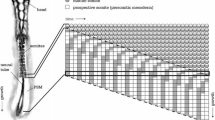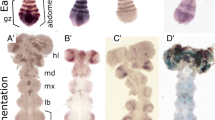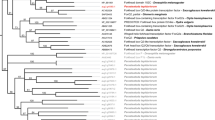Abstract
Notch signaling has been implicated in the segmentation of vertebrates but is not involved in segmentation in Drosophila. Recent evidence, however, implies that Notch signaling regulates segmentation in some Arthropods, including an insect, and that Notch signaling regulated segmentation in the common ancestor of Vertebrates and Arthropods. Notch signaling regulates clock-like formation of segments in both groups, a phenomenon not seen in Drosophila. We present evidence that Notch signaling components are expressed in a pattern implying a role in segmentation in honeybees, where the expression of genes involved in segmentation are modulated in a temporal way. Despite this, pharmacological investigation and RNA interference experiments indicate that Notch signaling does not regulate segmentation in honeybees, but instead regulates patterning within segments after segmentation itself has occurred. Notch signaling thus does not regulate segmentation in holometabolous insects, even when segments appear to form in anterior−posterior sequence.






Similar content being viewed by others
References
Alton AK, Fechtel K, Terry AL, Meikle SB, Muskavitch MA (1988) Cytogenetic definition and morphogenetic analysis of Delta, a gene affecting neurogenesis in Drosophila melanogaster. Genetics 118(2):235–245
Altschul S, Gish W, Miller W, Myers E, Lipman D (1990) Basic local alignment search tool. J Mol Biol 215(3):403–410
Artavanis-Tsakonas S, Muskavitch MA, Yedvobnick B (1983) Molecular cloning of Notch, a locus affecting neurogenesis in Drosophila melanogaster. Proc Natl Acad Sci USA 80(7):1977–1981
Baker NE (1988) Localization of transcripts from the wingless gene in whole Drosophila embryos. Development 103(2):289–298
Beye M, Hartel S, Hagen A, Hasselmann M, Omholt SW (2002) Specific developmental gene silencing in the honey bee using a homeobox motif. Insect Mol Biol 11(6):527–532
Chipman AD, Akam M (2008) The segmentation cascade in the centipede strigamia maritima: involvement of the notch pathway and pair-rule gene homologues. Dev Biol 319:160–169
Damen WG (2002) Parasegmental organization of the spider embryo implies that the parasegment is an evolutionary conserved entity in arthropod embryogenesis. Development 129(5):1239–1250
Dearden PK, Akam ME (2000) A role for fringe in segment morphogenesis but not segment formation in the grasshopper, Schistocerca gregaria. Dev Genes Evol 210(7):329–336
Dearden P, Akam ME (2001) Early embryo patterning in the grasshopper, schistocerca gregaria; wingless, dpp and caudal expression. Development 128(18):3435–3444
Dearden PK, Wilson MJ, Sablan L, Osborne PW, Havler M, McNaughton E, Kimura K, Milshina NV, Hasselmann M, Gemp T, Schioett M, Brown SJ, Elsik CG, Holland PW, Kadowaki T, Beye M (2006) Patterns of conservation and change in honey bee developmental genes. Genome Res 16:1376–1384
Dearden PK, Duncan EJ, Wilson MJ (2010) The honeybee Apis mellifera. In: Crotty DA, Gann A (eds) Emerging model organisms: a laboratory manual 2, vol 2. Cold Spring Harbor Laboratory Press, New York
Dequéant ML, Pourquié O (2008) Segmental patterning of the vertebrate embryonic axis. Nat Rev Genet 9(5):370–382
Dove H, Stollewerk A (2003) Comparative analysis of neurogenesis in the myriapod Glomeris marginata (Diplopoda) suggests more similarities to chelicerates than to insects. Development 130(10):2161–2171
Dovey HF, John V, Anderson JP, Chen LZ, de Saint AP, Fang LY, Freedman SB, Folmer B, Goldbach E, Holsztynska EJ, Hu KL, Johnson-Wood KL, Kennedy SL, Kholodenko D, Knops JE, Latimer LH, Lee M, Liao Z, Lieberburg IM, Motter RN, Mutter LC, Nietz J, Quinn KP, Sacchi KL, Seubert PA, Shopp GM, Thorsett ED, Tung JS, Wu J, Yang S, Yin CT, Schenk DB, May PC, Altstiel LD, Bender MH, Boggs LN, Britton TC, Clemens JC, Czilli DL, Dieckman-McGinty DK, Droste JJ, Fuson KS, Gitter BD, Hyslop PA, Johnstone EM, Li WY, Little SP, Mabry TE, Miller FD, Audia JE (2001) Functional gamma-secretase inhibitors reduce beta-amyloid peptide levels in brain. J Neurochem 76(1):173–181
Duncan EJ, Dearden PK (2010) Evolution of a genomic regulatory domain: the role of gene co-option and gene duplication in the enhancer of split complex. Genome Res 20:917–928
DuPraw EJ (1967) The honeybee embryo. In: Wilt FH, Wessells NK (eds) Methods in developmental biology. Thomas Y Cromwell Company, New York, pp 183–217
Felsenstein J (2004) Phylip (phylogeny inference package) version 3.6. Department of Genome Sciences, University of Washington, Seattle
Fleig R, Sander K (1986) Embryogenesis of the honeybee Apis mellifera l. (Hymenoptera: Apidae): an SEM study. Int J Insect Morphol Embryol 15(5):449–462
Forsberg H, Crozet F, Brown NA (1998) Waves of mouse lunatic fringe expression, in four-hour cycles at two- hour intervals, precede somite boundary formation. Curr Biol 8(18):1027–1030
Hartley DA, Xu TA, Artavanis-Tsakonas S (1987) The embryonic expression of the Notch locus of Drosophila melanogaster and the implications of point mutations in the extracellular EGF-like domain of the predicted protein. EMBO J 6(11):3407–3417
Henry CA, Urban MK, Dill KK, Merlie JP, Page MF, Kimmel CB, Amacher SL (2002) Two linked hairy/enhancer of split-related zebrafish genes, her1 and her7, function together to refine alternating somite boundaries. Development 129(15):3693–3704
Holley SA, Geisler R, Nüsslein-Volhard C (2000) Control of her1 expression during zebrafish somitogenesis by a delta-dependent oscillator and an independent wave-front activaity. Genes Dev 14:1678–1690
Holley SA, Jülich D, Rauch GJ, Geisler R, Nüsslein-Volhard C (2002) Her1 and the notch pathway function within the oscillator mechanism that regulates zebrafish somitogenesis. Development 129(5):1175–1183
Hrabé de Angelis M, McIntyre J 2nd, Gossler A (1997) Maintenance of somite borders in mice requires the Delta homologue dll1. Nature 386(6626):717–721
Hughes CL, Kaufman TC (2002) Exploring myriapod segmentation: the expression patterns of even-skipped, engrailed, and wingless in a centipede. Dev Biol 247(1):47–61
Huson DH, Richter DC, Rausch C, Dezulian T, Franz M, Rupp R (2007) Dendroscope: an interactive viewer for large phylogenetic trees. BMC Bioinform 8:460
Itoh M, Kim CH, Palardy G, Oda T, Jiang YJ, Maust D, Yeo SY, Lorick K, Wright GJ, Ariza-McNaughton L, Weissman AM, Lewis J, Chandrasekharappa SC, Chitnis AB (2003) Mind bomb is a ubiquitin ligase that is essential for efficient activation of notch signaling by delta. Dev Cell 4(1):67–82
Jouve C, Palmeirim I, Henrique D, Beckers J, Gossler A, Ish-Horowicz D, Pourquié O (2000) Notch signaling is required for cyclic expression of the hairy-like gene hes1 in the presomitic mesoderm. Development 127(7):1421–1429
Jülich D, Hwee Lim C, Round J, Nicolaije C, Schroeder J, Davies A, Geisler R, Lewis J, Jiang YJ, Holley SA (2005) Beamter/deltac and the role of notch ligands in the zebrafish somite segmentation, hindbrain neurogenesis and hypochord differentiation. Dev Biol 286(2):391–404
Kadner D, Stollewerk A (2004) Neurogenesis in the chilopod Lithobius forficatus suggests more similarities to chelicerates than to insects. Dev Genes Evol 214(8):367–379
Krauss V, Pecyna M, Kurz K, Sass H (2004) Phylogenetic mapping of intron positions: a case study of translation initiation factor eif2{gamma}. Mol Biol Evol 22(1):74–84
Lai EC (2004) Notch signaling: control of cell communication and cell fate. Development 131(5):965–973
Lehmann R, Jimenez F, Deitrich U, Campos-Ortega JA (1983) On the phenotype and development of mutants of early neurogenesis in Drosophila melanogaster. Roux’s Arch Dev Biol 192(2):62–74
Liang Z, Biggin MD (1998) Eve and ftz regulate a wide array of genes in blastoderm embryos: the selector homeoproteins directly or indirectly regulate most genes in Drosophila. Development 125(22):4471–4482
McGrew MJ, Dale JK, Fraboulet S, Pourquié O (1998) The lunatic fringe gene is a target of the molecular clock linked to somite segmentation in avian embryos. Curr Biol 8(17):979–982
Micchelli CA, Esler WP, Kimberly WT, Jack C, Berezovska O, Kornilova A, Hyman BT, Perrimon N, Wolfe MS (2003) Gamma-secretase/presenilin inhibitors for alzheimer’s disease phenocopy notch mutations in Drosophila. FASEB J 17(1):79–81
Müller M, v Weizsäcker E, Campos-Ortega JA (1996) Expression domains of a zebrafish homologue of the Drosophila pair-rule gene hairy correspond to primordia of alternating somites. Development 122(7):2071–2078
Nagy LM, Carroll S (1994) Conservation of wingless patterning functions in the short-germ embryos of Tribolium castaneum. Nature 367(6462):460–463
Oates AC, Ho RK (2002) Hairy/e(spl)-related (her) genes are central components of the segmentation oscillator and display redundancy with the delta/notch signaling pathway in the formation of anterior segmental boundaries in the zebrafish. Development 129(12):2929–2946
Osborne P, Dearden PK (2005a) Expression of pax group III genes in the honeybee (Apis mellifera). Dev Genes Evol 215:499–508
Osborne P, Dearden PK (2005b) Non-radioactive in situ hybridisation to honeybees embryos and ovaries. Apidologie 36:113–118
Palmeirim I, Henrique D, Ish-Horowicz D, Pourquié O (1997) Avian hairy gene expression identifies a molecular clock linked to vertebrate segmentation and somitogenesis. Cell 91(5):639–648
Peel AD, Chipman AD, Akam M (2005) Arthropod segmentation: beyond the Drosophila paradigm. Nat Rev Genet 6(12):905–916
Pueyo JI, Lanfear R, Couso JP (2008) Ancestral notch-mediated segmentation revealed in the cockroach Periplaneta americana. Proc Natl Acad Sci USA 105(43):16614–16619
Ronquist F, Huelsenbeck JP (2003) Mrbayes 3: Bayesian phylogenetic inference under mixed models. Bioinformatics 19(12):1572–1574
Savard J, Tautz D, Richards S, Weinstock GM, Gibbs RA, Werren JH, Tettelin H, Lercher MJ (2006) Phylogenomic analysis reveals bees and wasps (hymenoptera) at the base of the radiation of holometabolous insects. Genome Res 16(11):1334–1338
Schoppmeier M, Damen WG (2005) Suppressor of hairless and presenilin phenotypes imply involvement of canonical notch-signaling in segmentation of the spider Cupiennius salei. Dev Biol 280(1):211–224
Schroeter EH, Kisslinger JA, Kopan R (1998) Notch-1 signaling requires ligand-induced proteolytic release of intracellular domain. Nature 393(6683):382–386
Stollewerk A (2002) Recruitment of cell groups through delta/notch signaling during spider neurogenesis. Development 129(23):5339–5348
Stollewerk A, Simpson P (2005) Evolution of early development of the nervous system: a comparison between arthropods. BioEssays 27(9):874–883
Stollewerk A, Schoppmeier M, Damen WG (2003) Involvement of Notch and Delta genes in spider segmentation. Nature 423(6942):863–865
Takke C, Campos-Ortega JA (1999) Her1, a zebrafish pair-rule like gene, acts downstream of notch signaling to control somite development. Development 126(13):3005–3014
Tautz D (2004) Segmentation. Dev Cell 7(3):301–312
Tomancak P, Berman BP, Beaton A, Weiszmann R, Kwan E, Hartenstein V, Celniker SE, Rubin GM (2007) Global analysis of patterns of gene expression during drosophila embryogenesis. Genome Biol 8(7):R145
Walters JW, Münoz C, Paaby AB, Dinardo S (2005) Serrate-notch signaling defines the scope of the initial denticle field by modulating EGFR activation. Dev Biol 286(2):415–426
Whelan S, Goldman N (2001) A general empirical model of protein evolution derived from multiple protein families using a maximum-likelihood approach. Mol Biol Evol 18(5):691–699
Wilson MJ, Dearden PK (2009) Tailless patterning functions are conserved in the honeybee even in the absence of torso signaling. Dev Biol 335(1):276–287
Wilson MJ, Havler M, Dearden PK (2010) Giant, krüppel, and caudal act as gap genes with extensive roles in patterning the honeybee embryo. Dev Biol 339(1):200–211
Acknowledgements
The authors wish to thank N. Kenny, E. Duncan and S. Morgan for critical comments on this manuscript. We would also like to thank Betta Bees Research LTD for bee supply and support. This work was funded by a Royal Society of New Zealand Marsden Grant to PKD (UOO0401).
Author information
Authors and Affiliations
Corresponding author
Additional information
Communicated by S. Roth
MJW carried out RNAi injections and analysis, BHMcK cloned Am-Delta and Am-Notch. SvdH assisted with pharmacological experiments. PKD conceived the study, cloned Am-fringe, carried out pharmacological investigation, in-situ hybridization, and phylogenetics and wrote the paper.
Rights and permissions
About this article
Cite this article
Wilson, M.J., McKelvey, B.H., van der Heide, S. et al. Notch signaling does not regulate segmentation in the honeybee, Apis mellifera . Dev Genes Evol 220, 179–190 (2010). https://doi.org/10.1007/s00427-010-0340-6
Received:
Accepted:
Published:
Issue Date:
DOI: https://doi.org/10.1007/s00427-010-0340-6




